15 Jul 2003, Australia --- Dinosaur prints, Gantheaume Point, Broome, Australia --- Image by © Matthias Breiter/Minden Pictures/Corbis
Mighty footprints with a view of Gantheaume Point, Broome. These replicas belong to a large carnivorous dinosaur. Image: © Matthias Breiter
On a sandy bank of north-western Australia, a flock of monstrous birds stride about in the shallow water — silty mud oozes up between their toes. Among their feathered numbers is a Woodstock of droppings, downy feathers, and clashing footprints. These birds are fearsome, toothed, tailed, and not birds at all, but their forebears: theropod dinosaurs, the group that contains the Velociraptor and T. rex.
The muddy sand that these animals walked in is now stone, and these tracks can be found up and down the 100 km stretch of the Dampier Peninsula coastline, also known as the ‘Dinosaur Coast’.
Those three toed bird-like theropod tracks are by no means the only prints around the coast. Some were also left behind by sauropods with feet 1.5 metres in diameter — that is 5’. At least 16 different types of dinosaurs left their impressions with thousands of tracks, even some from ghostly species for which there is no other evidence.
- Dr Steven Salisbury standing over a theropod track. Some of these animals stood 1.7 metres tall at the hip. Erin Parke/ABC Kimberley.
- Dr Salisbury’s walking with modern-day dinosaurs: an egret in this case. What will scientists in the deep future make of those sandal prints?
To garner all we can about these spectacular fossil tracks, the Walking with Dinosaurs in the Kimberley research project was born, funded through the Australian Research Council Discovery Project scheme. Headed up by Dr Steve Salisbury from The University of Queensland and Associate Professor Jorg Hacker from Airborne Research Australia at Flinders University, the project brings together an array of experienced and skilled groups including two of our researchers: Dr Robert Zlot, head of Robotic Perception, and George Poropat, Senior Principal Research Scientist in our Energy Flagship.
Together with Dr Mike Bosse from ETH, Zurich, the team is working closely with Goolarabooloo Traditional Custodians and Yawuru Native Title holders to help locate and map the tracks.
Our researchers have been helping the palaeontologists by documenting the 130 million year old tracks using sophisticated 3D imaging technology developed here in our Energy and Digital Productivity Flagships. They have also trained the Queensland team to use the equipment for independent expeditions with the resulting data being sent back to our scientists for processing.
The world to Zebedee, one of our 3D imaging technologies. Image captured by Anthony Romilio, data compiled by our researchers.
Since GPS data are imprecise, other more specialised devices and techniques are also required. The highest resolution data are gathered by a modified photomapping technology called Sirovision and extensions to some commercial packages. These data can be used to generate high-quality 3D outputs of the subject, providing sub-millimetre scale models of footprints.
On a larger scale, Assoc. Prof. Hacker scans the tracks using a specially equipped low-flying aircraft, soaring just 10 m over the rock platforms. The aircraft captures mapping data (high-resolution photos, video, and lidar imagery) as it flies overhead. The data captured by this aircraft can be georeferenced with those from the Sirovision device, enabling data of different scales and resolutions to be integrated.
Airborne Research Australia – piloted by Associate Professor Jorg Hacker. Photo: Damian Kelly
And at yet another scale, we have the amazing Zebedee.
Zebedee is a handheld lidar (portmanteau of light-radar) that maps the environment as you walk. You simply meander through a site holding Zebedee as it beams out 2D ‘sheets’ of laser up to 15 metres into the environment. As it does so, it eagerly rocks back and forth on a spring, making those 2D sheets of information overlap again and again to form a dense and accurate 3D map of the environment. Zebedee initially arose from research into 3D mapping for autonomous robots.
Zebedee has been used to map crime scenes, heritage sites, the interior of the Leaning Tower of Pisa, and now the footprints of reptiles past.
As well as using our nifty Zebedee, Dr Salisbury and the team have also been using a drone to map the prints from above, a perspective on the animals’ movements impossible from human height.
The tides along the coastline are extreme, at some points drawing back 10 metres down the rock platform before creeping back again. The team must do their work in just a few hours before the tides rise up.

A GIF of the rising tides while the team works. Photos: Steve Salisbury
As well as recreating the tracks with high fidelity, Zebedee and the other tools and techniques are integral for preserving these wonders. The tracks are ephemeral and are constantly being eroded by the relentless sea. “A number of tracks that we have documented last year have disappeared as a result of sand movements during the 2014-15 storm,” said Steve.
The Walking with Dinosaurs project is science at its finest: palaeontological rigour, traditional insight, and sophisticated aircraft and imaging equipment. By using these cutting-edge technologies, scientists are simultaneously preserving and recreating an ancient world that would be otherwise unimaginable.
To follow the project, Dr Salisbury (@implexidens) and Dr Romilio (@a_romilio) are on Twitter. For more information about our wonderful Zebedee, check out this page.
- A theropod toe print. The indent produced by the claw and toe pad are clearly visible. Ben Collins/ABC Kimberley
- George Poropat gathering photogrammetric data. Photo: Damian Kelly
- Steve gathering photogrammetric data. Photo: Damian Kelly.
- Dr Salisbury scrubbing up some Megalosauropus prints in preparation for documentation. Photo: Damian Kelly
- Mike Bosse with Zebedee. Photo: Steve Salisbury
- Dr Robert Zlot holding Zebedee. Photo: Damian Kelly


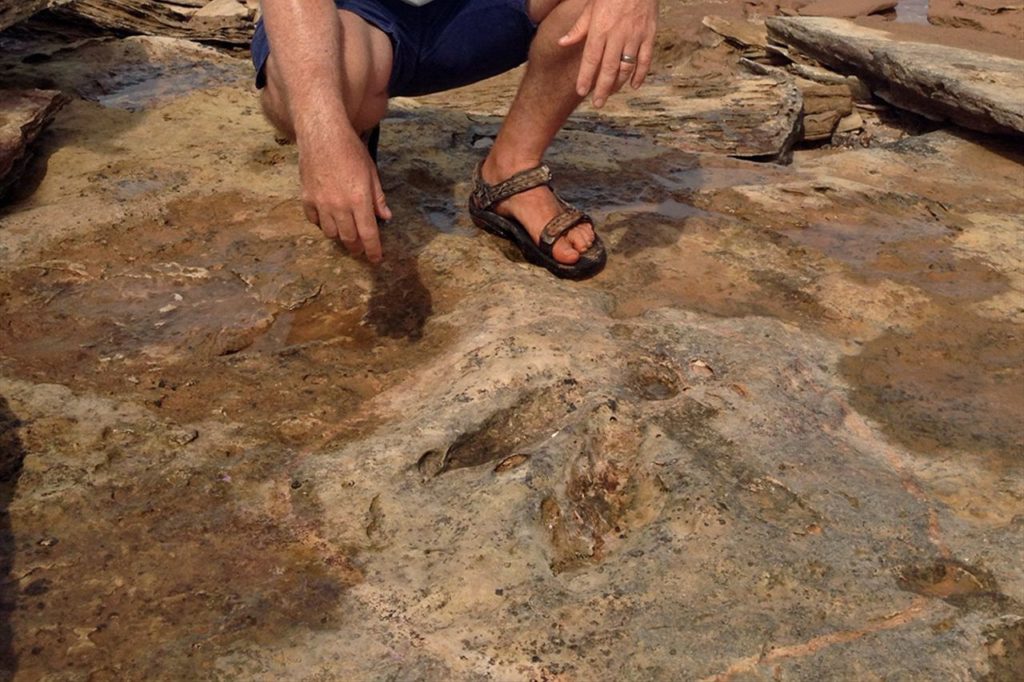


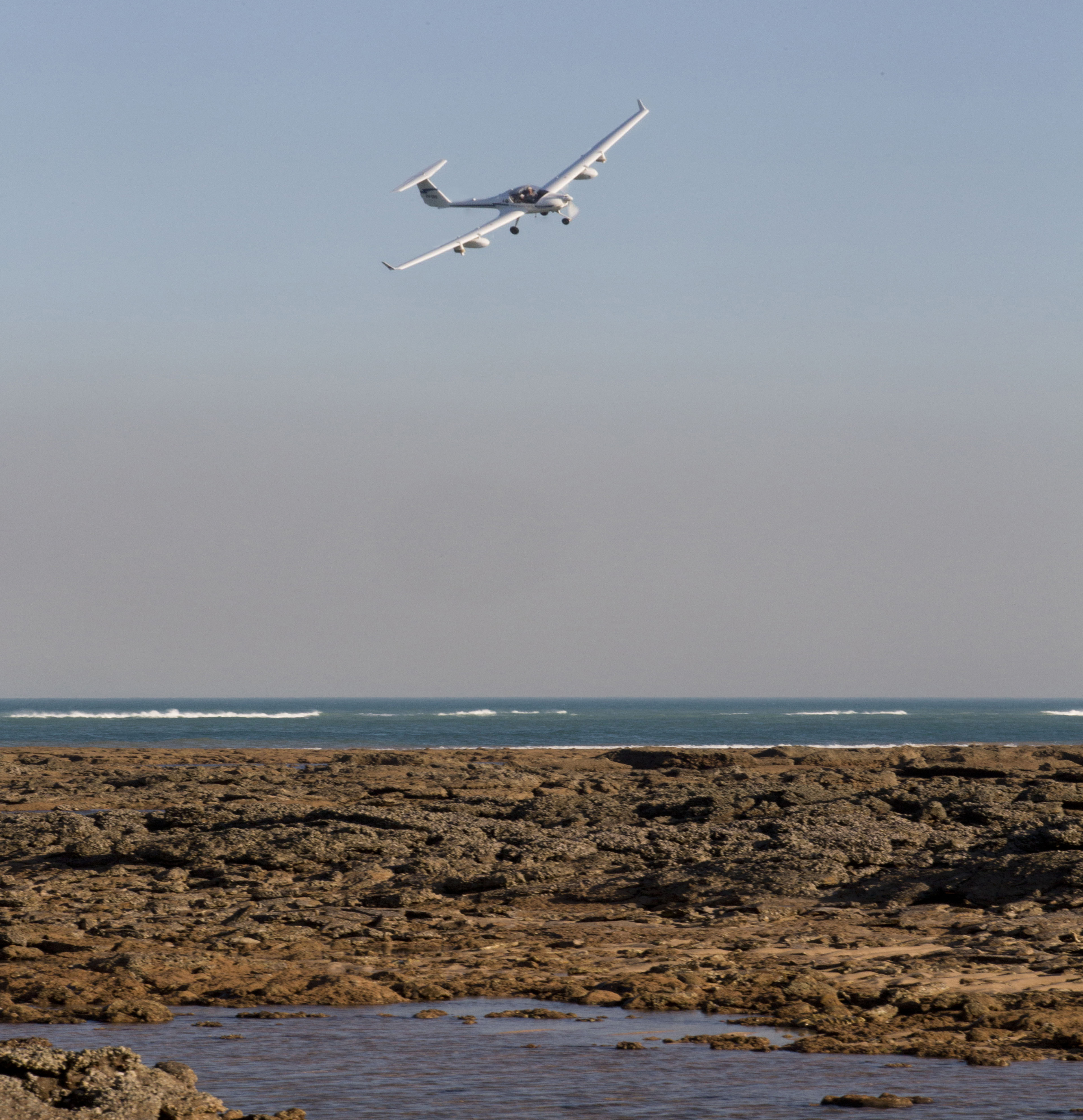
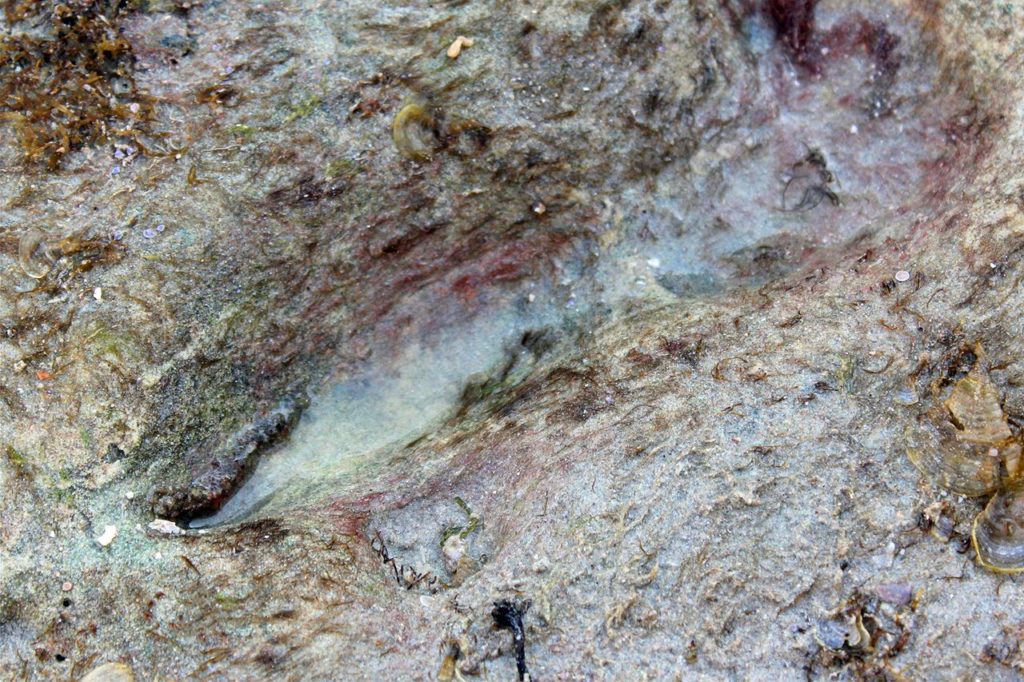
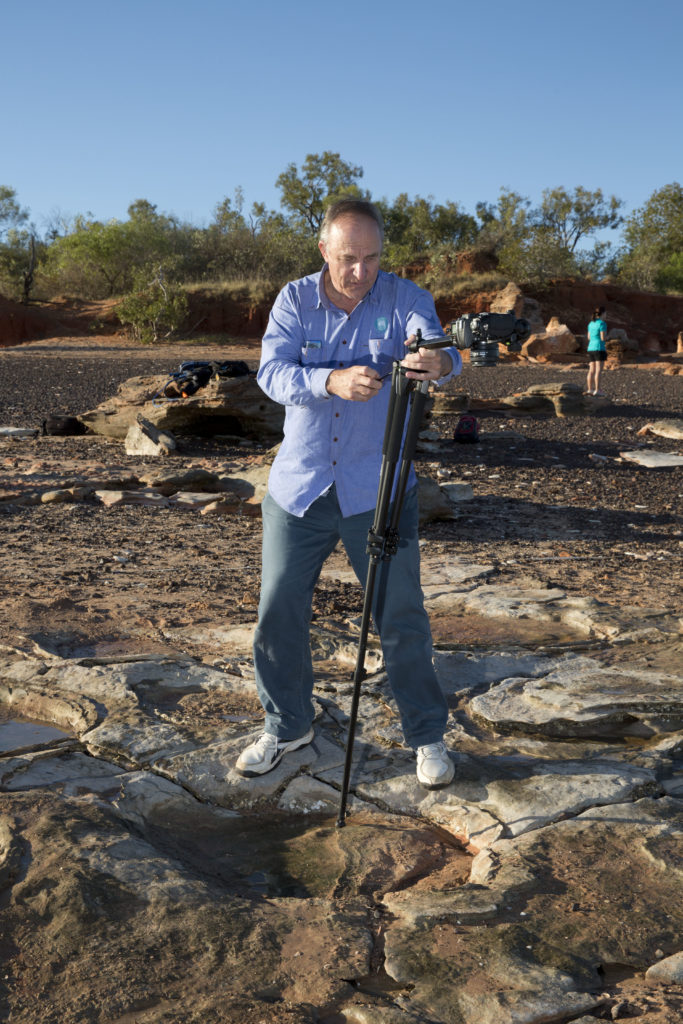

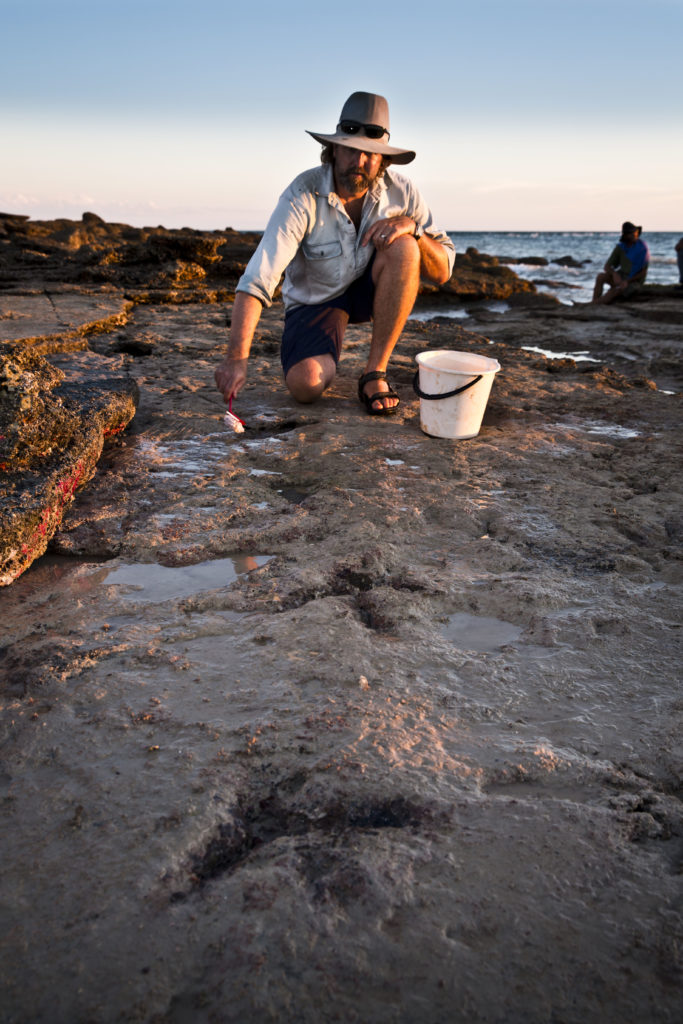
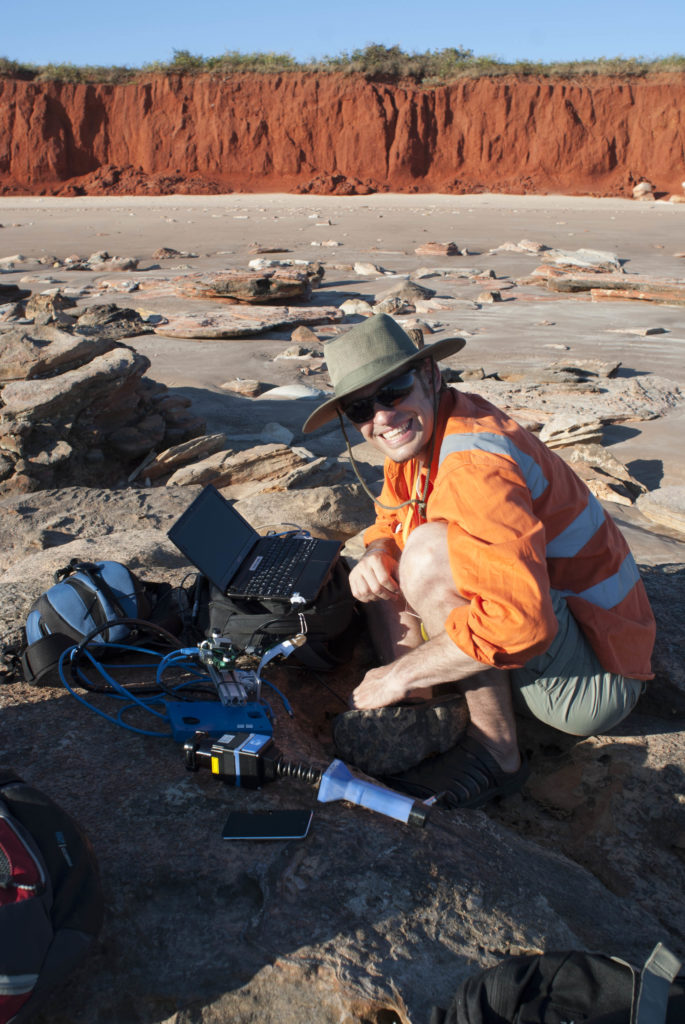
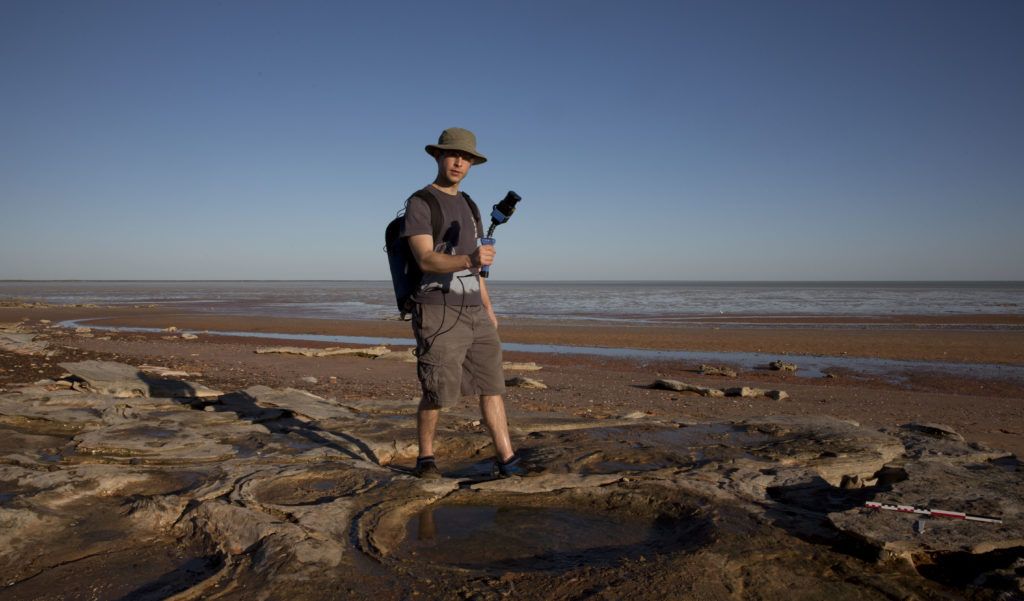

29th March 2017 at 10:42 pm
It is great to see that research is continuing on the Broome dinosaur footprints.
However, I am quite sad to see that the prior, and in fact initial researchers are not acknowledged in this article. Tony Thulborn, Tim Hamley and company studied these amazing relics in the 1990’s. Techniques for mapping footprints were not quite as advanced as they are now however these researchers certainly contributed greatly to the Broome Dinosaur footprint knowledge base. As the scientific method is based on systematic observation, measurement and experimentation, acknowledgment of the previous observers, measurers and experimenters is usually standard procedure.
I knew one of these prior researchers intimately and hence knew his passion and knowledge of the Broome dinosaur footprints. Please acknowledge those that have contributed greatly to these wonderful relics that deserve further research and investigation. Thank you.
10th June 2015 at 9:48 pm
I appreciate your thought that children can easily learn and get more knowledge on the Dinosaur.
Thanks for the sharing an amazing blog on the Walking Dinosaurs.
Walking Dinosaur
8th May 2015 at 7:08 pm
If there were in fact dinosaurs of numerous kinds and in such large numbers that inhabited the earth in the past, why are fossils and skeletons so rare to find?
How does anyone know they existed 130 million years ago? That’s a long time for a human to be sure of when we ourselves have trouble accurately determining events that happened 2000 years ago.
I’ve heard that the dinosaurs became extinct from an ice age or perhaps a meteor. A meteor would only land on one side of the earth so the other side should be ok! Why are there reports of dinosaurs in countries on opposite sides of the earth?
If they died from an ice age then the earth’s climate has been changing for 130 million years even when humans weren’t around. Therefore, it probably will still change over the next 130 million years, despite mans existence. So, what is all the hype of ‘climate change’ really about? Could it be a man inspired theory to frighten the world into action to prevent this ” so called” threat? We now know that the “clean energy” “green energy” “alternate energy” and “renewable energy” industries are big business and largely funded by governments. We also know that the most efficient and cost effective source of providing electricity is from burning coal.
Wind power is almost useless and there are studies into the negative medical effects of wind turbines on local residents. The cost of wind power has been highly subsidized by previous governments for no real benefit.
Solar is good when the sun shines but useless when it doesn’t.
Back to dinosaurs. what does the CSIRO spend on it’s research into the pre existence of creatures before our time and what benefit will we gain from this research? Will it improve our lives or impart some beneficial information that will make human beings better people?
I doubt it.
The CSIRO is a government funded organisation that has become a self justifying department that uses “tax payers” money to fund it’s ‘so called’ research and then release it’s findings for the media and general public to accept as the undisputed science on whatever topic they choose to research.
I disagree with a lot of what the CSIRO has published and I recommend that all Australians scrutinize what they publish as fact and ask questions and call the CSIRO to account. The CSIRO only exist because of your taxes.
9th May 2015 at 3:49 am
I would hesitate to use such language as “how dumb and ignorant can you get?” for fear that folk would take it on as a challenge. CSIRO has directly improved my life and I am in America (it doesn’t begain to make up for sending us Rupert Murdoch, but it is a start)
I would dearly wish that CSIRO would reach out more internationally, and have even tried to get some sort of job with them to help with my Desalinator and Wave energy work that is dead in the water for lack of funds.
Creating opportunities to empower ordinary people to make huge contributions to society is among the finest things a Government can hope to do, and a CSIRO founding goal. That their efforts will be (and is already) a major positive for Australians and the rest of the World, far beyond their costs of doing so, is already obvious to anyone with the ability to even use a computer I would think, but the critical thinking skills that can sort out the value of information about the Reptilian ancestors of Birds, and stories about our Reptilian overseers that are secretly running the world, is something in much greater need and shorter supply than I would ever have believed.
Perhaps Australia could fund a world effort to teach critical thinking skills, that their countryman has spent so many billions of dollars to destroy.
10th May 2015 at 7:54 pm
Are you replying to my previous diatribe or were you referring to something else you’ve read? In your first sentence you have quoted me as saying something I did not say and you have also made a slur at a very successful Australian businessman. Your second paragraph is quite clever if it is meant to be funny. We have a desalination plant in NSW that has never been used but still costs millions of dollars each year to maintain. Your “wave energy work” that is ‘dead in the water’ is a classic comic line – well done!
Your third paragraph is your most revealing. You use a phrase which would have to be among my top 5 most hated combination of words – “empower ordinary people”.
I’m yet to make a distinction between ordinary people and people who aren’t ordinary and I am yet to meet a man who admits to being “empowered”, whatever that means, so I assume you are a woman.
If you love the CSIRO but also criticize the Australian people then maybe you are the one who needs to reassess your “critical thinking skills”.
10th May 2015 at 8:21 pm
Hi, dragonwlkr.
Thank you for reading the article, I hope you enjoyed it. I also appreciate your interest in palaeontology and climate science. But unfortunately I’m going to request you to restrict your comments to those topics and not other individuals.
Thanks again,
Jess
10th May 2015 at 11:32 am
I suggest you not comment on things you have no education in at all, you’re embarassing yourself.
“If there were in fact dinosaurs of numerous kinds and in such large numbers that inhabited the earth in the past, why are fossils and skeletons so rare to find?”
Think about the combination of processes that are required to be able to preserve a fossil for that long, and then couple that with the chance that this fossil is at the surface at this point of time to be observed (because to preserve these they need to be buried), AND that we even find it in the first place. Thats ignoring physical processes such as erosion etc which may also destroy the fossils before we find them. That’s why.
“How does anyone know they existed 130 million years ago?”
Go read about isotope dating.
“a meteor would only land on one side of the earth so the other side should be ok! ”
I’ll use an analogy which you’ll be familiar with, as I’m sure you’ve watched movies etc. Ever heard of a nuclear winter? Volcanic winter? A large enough impact would have an effect on the climate of the whole planet, it wasn’t an isolated explosion that killed them all.
“If they died from an ice age then the earth’s climate has been changing for 130 million years even when humans weren’t around. Therefore, it probably will still change over the next 130 million years, despite mans existence.”
Yes. Yes it has. Again you’ve clearly never read anything about this subject except what you’ve read on your tinfoil hat websites. The climate has always been changing.
” So, what is all the hype of ‘climate change’ really about? Could it be a man inspired theory to frighten the world into action to prevent this ” so called” threat?”
The threat is that we are injecting molecules into our atmosphere at a rate never seen before in earth history that can affect the climate. The debate isn’t about climate change, yes that will happen slowly, the problem is that we have dramatically sped up this process so that now it may pose an issue within the next few generations, rather than, to quote you above, timescales of millions of years.
Again, please don’t share misinformed ideas until you’ve taken the time to at least have some idea of how these processes work. Just because YOU don’t understand how something works, doesn’t make it some voodoo theory.
10th May 2015 at 7:52 pm
To Matt
thanks for the condescending reply, however, I believe these pages are for all opinions and just because YOU don’t agree with my opinion doesn’t diminish my right to express it or challenge the information being put forth.
Despite your snobbish assumptions that I am ill informed I have spent many hours (after work) reading about the subject of climate change from various sources over several years.
I’m not embarrassed by my questions and comments on this page, and for an intelligent person like you it’s a rather unintelligent comment to make that I am embarrassing myself.
Surely, embarrassment is a personal emotion not an external affect of the thoughts of other people.
Well, now that we’re friends, do you work for the CSIRO?
10th May 2015 at 8:21 pm
Hi, Matt.
Thank you for reading the article, I hope you enjoyed it. I also appreciate your interest in palaeontology and climate science. But unfortunately I’m going to request you to restrict your comments to those topics and not other individuals.
Thanks again,
Jess
10th May 2015 at 8:20 pm
Hi, David.
Thank you for reading the article, I hope you enjoyed it. I also appreciate your interest in palaeontology and climate science. But unfortunately I’m going to request you to restrict your comments to those topics and not other individuals.
You’re welcome to ask questions and scrutinise CSIRO’s research, their research papers are available online. The papers for these particular palaeontological studies haven’t been published yet, but you can keep an eye on Dr Salisbury’s lab at The University of Queensland for when they are. The results of those papers are also free to be challenged, and those challenges published after the appropriate peer-reviewed processes.
Many thanks,
Jess